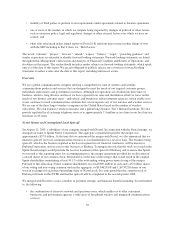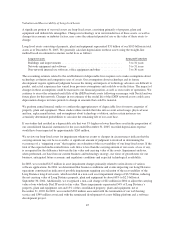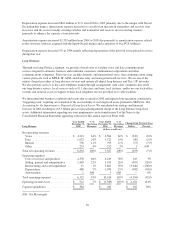Sprint - Nextel 2005 Annual Report Download - page 58
Download and view the complete annual report
Please find page 58 of the 2005 Sprint - Nextel annual report below. You can navigate through the pages in the report by either clicking on the pages listed below, or by using the keyword search tool below to find specific information within the annual report.In determining pension obligations, we are required to develop assumptions for the discount rate and return on
plan assets. These assumptions are subject to market performance, which has fluctuated in the recent past and
could have continued volatility in the future. In selecting our discount rate, our third party actuaries construct a
hypothetical portfolio of bonds rated AA- or better that produces a cash flow matching the projected benefit
payments of the plan. For the December 31, 2005 measurement date, this exercise produced a range of
5.67% - 5.87%, and our discount rate was set at 5.75%, a 25 basis point decrease from December 31, 2004. An
increase in the discount rate would reduce the reported projected benefit obligation. In contrast, if the discount
rate used in 2005 in determining the projected benefit obligation was 25 basis points lower, it would generate a
$179 million increase in the projected benefit obligation reported on the balance sheet, and a $27 million increase
in the benefit costs.
Our return on asset assumption is 8.75% and has not changed since late 2003. To determine our assumption for
the return on assets, we consider forward-looking estimates of the expected long-term returns for a portfolio
invested according to our target investment policy. This assumption was initially developed from estimates
provided by two investment consulting firms in late 2003 when we revised our target asset allocation policy, and
is validated each year against estimates provided by our third party actuaries. If the expected return on assets
assumption was 25 basis points lower, it would generate a $9 million increase in current year benefit costs. This
assumption is not used in the calculation of the pension projected benefit obligation.
In determining post-retirement medical and life insurance benefit obligations, assumptions are made concerning the
cost of health care, including medical inflation and discount rates. A one-percentage point increase in the assumed
medical inflation rate would generate a $37 million increase in the accumulated postretirement benefit obligation
reported on the balance sheet, and a $2 million increase in benefit costs. An increase in the discount rate would
reduce the reported accumulated postretirement benefit obligation. In contrast, if the discount rate used in 2005 in
determining the accumulated postretirement benefit obligation was 25 basis points lower, it would generate a $16
million increase in the obligation as of December 31, 2005 and an immaterial impact on benefit costs.
Tax Valuation Allowances
We are required to estimate the amount of tax payable or refundable for the current year and the deferred income
tax liabilities and assets for the future tax consequences of events that have been reflected in our financial
statements or tax returns for each taxing jurisdiction in which we operate. This process requires our management
to make assessments regarding the timing and probability of the ultimate tax impact. We record valuation
allowances on deferred tax assets if we determine it is more likely than not that the asset will not be realized.
Additionally, we establish reserves when, despite our belief that our tax return positions are fully supportable,
certain positions could be challenged, and the positions may not be fully sustained. Actual income taxes could
vary from these estimates due to future changes in income tax law, the expected spin-off of Embarq, significant
changes in the jurisdictions in which we operate, our inability to generate sufficient future taxable income or
unpredicted results from the final determination of each year’s liability by taxing authorities. These changes
could have a significant impact on our financial position.
The accounting estimate related to the tax valuation allowance requires us to make assumptions regarding the
timing of future events, including the probability of expected future taxable income and available tax planning
opportunities. These assumptions require significant judgment because actual performance has fluctuated in the
past and may do so in the future. The impact that changes in actual performance versus these estimates could
have on the realization of tax benefits as reported in our results of operations could be material.
We carried an income tax valuation allowance of $1.1 billion as of December 31, 2005. This amount includes a
valuation allowance for the total tax benefits related to net operating loss carryforwards, subject to utilization
restrictions, acquired in connection with certain acquisitions. The remainder of the valuation allowance relates to
capital loss, state net operating loss and tax credit carryforwards. Assumption changes that result in a reduction
of expected benefits from realization of capital loss, state net operating loss and tax credit carryforwards by 10%
would increase our valuation allowance by $55 million.
47
























